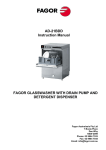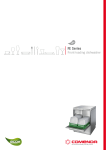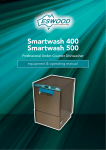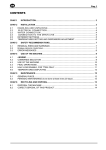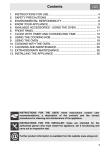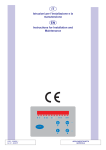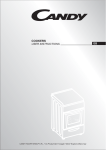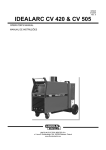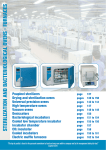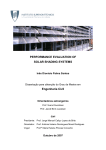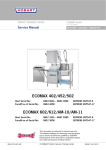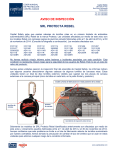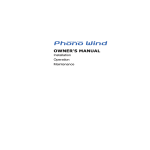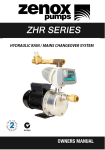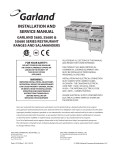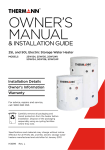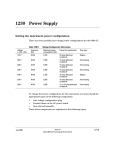Download AD-90+B+AD-120+B User Manual
Transcript
AD-90B / AD-120B Instruction Manual FAGOR PASS-THROUGH DISHWASHER WITH DRAIN PUMP Fagor Australasia Pty Ltd 7 Boola Place Dee Why NSW 2099 Phone: 02 9984 7533 Fax: 02 9984 7544 Email: [email protected] 1. POSITIONING 1.1 For the machine to work properly, you must ensure that it is level. Four threaded bolts (legs) are supplied with your machine. These should be fitted to the underside of the machine and adjusted to level the machine, as shown in Figure 1. Figure 1 2. INSTALLATION 2.1 Connect the mains to the water supply, as shown in Figures 2 and 3. The machine should be connected to a hot water supply of above 50°C but no more than 60°C to allow the machine to operate efficiently. I nlet operating pressure is 400 kPa and maximum inlet supply temperature is 60 °C 2.2 If the pressure is more than 70 PSI, a pressure limiting valve should be fitted. Figure 2 A= Water inlet D= Drain hose 25mm in diameter and must be installed in acordance with AS/NZS3500.2 (drainage) by means of coupled connection to a DN40 or larger pipe. E= Electric sheathed Cable M= Sheathed cable R= Connection strip NOTE: must be installed in accordance with AS/NZS3500.1 (water service supply) including installation of the supplied backflow prevention device Figure 3 1 E 1 S = Stopcock / F = Filter / H = Fagor supplied hose and backflow prevention device/ E = Electrovalve 2.3 Dynamic pressure during rinse is 2÷4 Kg/cm2. If the pressure is less than 2 kg/cm2 (28 PSI), an electrical pressure pump should be installed, as shown in Figure 4. Figure 4 1 E 1 S = Stopcock / F = Filter / H = Hose / E = Electrovalve / B = Electropump When the water hardness level is above 10º F, a water softener should be installed. 2.4 2.5 A stopcock (S) should be fitted below the machine’s water intake. See Fig. 3 & 4. Fix the drain hose as shown in Figure 5 and fit a siphon pipe to prevent bad smells. Please note the maximum height of the drain hose indicated on Figure 2. Note: Do not extend the length of the drain hose supplied with your machine. Figure 5 D 1 A 1 C=Drain collector / D =Drain hose 2.6 Connect the electrical connections, referring to Figures 2, 6 and 7. 2.7 For access to the connection strip (R), (Fig. 2), remove the cover and the rear panel. 2.8 Fix the sheathed cable to (E), leaving enough cable to remove the electrical panel from the front (Figure 2). 2.9 Connect the strip as shown in Figure 6. Figure 6 MODEL VOLTAGE MODEL S.cable=M AD – 90 4x2,5mm2 +T B 380-415V3N~ am/ve=yellow-green a= blue m= brown g= grey n= black 380-415V-3N~ AD – 120 B 4x6mm2 + T Fuses=F MAINS CONNECTIONS 25 A 40 A Fit a general switch (I) independent of the appliance with a distance between contacts equal to or more than 3mm. 2.10 The machine must be earthed. 2.11 All models have the option of reducing the maximum absorbed power as shown in Figure 7 below: Figure 7: MODEL AD-90B AD-120B Max. absorbed power when connected as shown in Fig. 7 6,800 13,200 Figure 8: Technical Specifications of AD-90B and AD-120B Model AD90B AD120B Water inlet pressure (200÷400 kPa) (2÷4 Kg/cm2) (28÷ 56 psi) 200÷400 kPa) (2÷4 Kg/cm2) (28÷ 56 psi) 3. Supply Voltage Tank Heating Element Boiler Heating Element Max. power used Basket size Cycle duration Tank capacity Rinse water consumed Net Weight 400-V3+N+E 25 A 3 Phase 4.5 KW 6 KW 11.10 KW 500x500 mm 55”, 75”, 120” 45 litres 3,5 litres/rinse 108 KG 400-V3+N+E 40 A 3 Phase 4.5 KW 12 KW 17.79 KW 500x500 mm 55”, 75”, 120” 45 litres 3,5 litres/rinse 118 KG USING YOUR AD-90B / AD-120B DISHWASHER WITH DRAIN PUMP 3.1 Put the blue hose (located at the back of the machine), into a bottle of rinse aid. Make sure that the filter on the ends of the pipe is fully submerged and the pipe is not kinked. 3.2 Prepare crockery for washing by removing large bits of food before loading the crockery into the baskets. Glassware should be washed first. Plates should not be stacked on top of each other (see Figure 9). Cups and glasses should be washed upside down. Cutlery should be washed in the yellow cutlery baskets with handles at the bottom; each yellow basket should contain a mixture of spoons, forks and knives for optimum washing conditions. The cutlery holders should be put into one of the baskets. Figure 9 3.3 Load the machine with a basket of dirty dishes/cutlery. Close the hood and press the switch button (2 on Figure 10) to turn machine on. Pilot light (1) will come on and the boiler and wash tank will begin to fill up with water and heat up. Figure 10 AD-90B / AD-120B 3.4 Wait for water to heat up to required temperature. The thermometer (9) indicates the rinse temperature and the thermometer (10)indicates the wash temperature. The machine is ready when the thermometer (9) indicates 85-90°C and the thermometer (10) indicates 55-60°C. The dishwasher is fitted with a thermostop to ensure a minimum rinse temperature of 85°C. The temperature of the incoming water should be 50°C or more. Colder water may affect the machine’s performance. There are 3 washing cycles P1(3), P2(5), P3(7) lasting 55”, 75” and 120” seconds respectively (Fig.10), as well as a Continous Washing cycle, which is activated on and off by pressing the button P3(7) for 3 seconds ( as shown in Fig.10). The appropriate LED (4,6 & 8 on Figure 10) will light up. 3.5 When the cycle has finished, the LED will go off. The door can be opened and the basket can be removed. Another basket of crockery can be inserted and button P1, P2 or P3 pressed for another wash cycle to start. Never place a basket of washed dishes on top of the machine; water could drip from the basket and damage the machine’s electrical components. 3.6 The dishwasher drains automatically in each cycle. At the end of each day or service, or as required, the dishwasher should be completely drained. To completely empty the tank, remove the anti-overflow device (drain plug) (A in figure 5), open the door and press the button P1 (3 in Figure 10) for 3 seconds. 4.- MAINTENANCE 4.1 Check the rinse liquid container on a daily basis to ensure levels are sufficient and the filters on the ends of the pipes are fully submerged. Check pipes leading from the containers for kinks. 4.2 Clean the filter- trays in the bottom and waste collector every day (See F on Fig. 3 and Fig. 11). 4.3 Remove the filter, clean it and put it back properly (Fig. 12).To generally clean the tub, remove the basket support (Fig. 13) and the anti-overflow device (Fig. 14). Then put them back properly. 4.4 Use soap and water for cleaning purposes, not abrasive detergents. Never use jets of water to clean the outside of the machine. Fig. 11 Fig. 12 Fig. 13 Fig. 14 4.5 Check that all parts are securely fixed, in particular that the screws on the wash and rinse arms have not worked loose. 4.6 If the machine is not going to be used for a long time, cover its surfaces with a coating of petroleum jelly. 5 ELECTRICAL AND MECHANICAL PROBLEMS – (TROUBLESHOOTING) The following should be checked before calling for technical service 5.1 If the machine has no power, check if it is plugged in to the power supply and that the voltage coincides with that required by the machine. 5.2 If the machine has no power, check if the power cord is damaged, in which case it should be replaced by the manufacturer or by its aftermarket service or by other qualified personnel in order to prevent hazards. 5.3 If the water connection or the start up take too long check the water supply is working at the required temperature and that the drain plug has been inserted. 5.4 If the machine is not rinsing or washing properly, check that the arms rotate properly and the nozzles are not blocked. To remove the rise arm, unscrew the thumb screw in the central support (using a coin). Wash the rinse arm in soapy water and reposition it. Tighten the screw. See figures below: Fig. 15 Fig. 16 Fig. 17 Fig. 18 5.5 If the machine is not washing or rinsing properly, check the levels of rinse aid and detergent and check that the supply pipes are not kinked and do not have an air bubble blocking them. 5.6 After sales service: Fagor Australasia Pty. Ltd., 7 Boola Place, Dee Why, NSW. Tel. 02 9984 7533 Email: [email protected] 6. INFORMATION FOR TECHNICIANS 6.1 CONFIGURATION OF THE DIPS FAGOR ELECTRIC ADVANCE MODEL DIP1 DIP2 DIP3 DIP4 AD- 90B ON OFF OFF OFF AD-120B ON OFF ON OFF CYCLE TIMES (seconds) P1= 55 / P2=75 / P3=120 P1= 55 / P2=75 / P3=120 DIP1 = ON, when the door is closed or the cover lowered, the dishwasher starts. DIP1= OFF, when the door is closed or the cover lowered, the dishwasher continues washing ONLY IF THE CYCLE HAS NOT FINISHED. DIP2 = OFF DIP1 + DIP3 , with the different possible combinations, we programme the cycle times. DIP4 = OFF 6.2 ERROR DIAGNOSIS. Faults are diagnosed with impulse trains from the ON/OFF LED. The trains are formed by “x” impulses lasting 0.5 seconds. (ON) and a wait of 2 seconds, as shown in the following figure: 1. ERROR: OPEN DOOR This is indicated by a one-impulse train. That is, the ON/OFF LED lights up for 0.5 seconds and then remains unlit for 2 seconds before lighting up again. This continues as long as the door is open and the selected cycle is unfinished. 2. TANK FILL ERROR. This is indicated by a two-impulse train. That is, the ON/OFF LED lights up twice for 0.5 seconds each time and then remains unlit for 2 seconds, then lighting up again twice. This continues while the water in the tank does not reach the correct level in the specified time. 3. TANK DRAINAGE ERROR. This is indicated by a three-impulse train. That is, the ON/OFF LED lights up three times for 0.5 seconds each time and then remains unlit for 2 seconds, then lighting up again three times. This continues while the drainage pump does not drain the water in the tank to the correct level in the specified time. 4. BOILER HEATING ERROR. This is indicated by a four-impulse train. That is, the ON/OFF LED lights up four times for 0.5 seconds each time and then remains unlit for 2 seconds, then lighting up again four times. This continues while the water in the boiler does not reach the correct temperature in the specified time. 5. TANK HEATING ERROR. This is indicated by a five impulse train. That is, the ON/OFF LED lights up five times for 0.5 seconds each time and then remains unlit for 2 seconds, then lighting up again five times. This continues while the water in the tank does not reach the correct temperature in the specified time. NOTE.- THE FINAL HOLDER OF THE CONTAINER WASTE IS RESPONSIBLE FOR ITS MANAGEMENT. The use of the WEEE symbol indicates that this product may not be treated as household waste. By ensuring this product is disposed of correctly, you will help protect the environment. For more detailed information about the recycling of this product, please contact your local authority, your household waste disposal service provider or the shop where you purchased the product.










